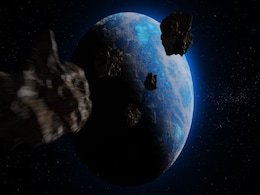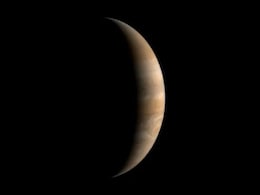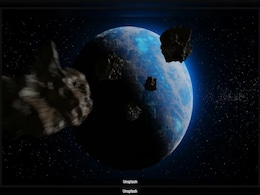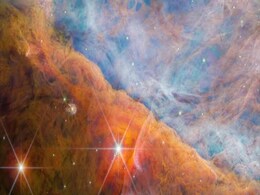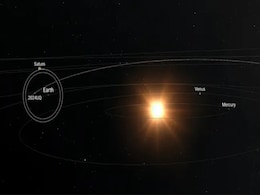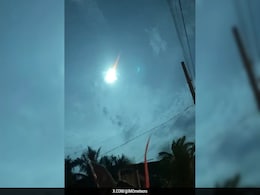Planetary Objects
- All
- News
-

Mysterious Planetary-Mass Objects May Form in Young Star System Clashes
- Wednesday March 12, 2025
- Written by Gadgets 360 Staff
Recent research challenges traditional views on planetary-mass objects, suggesting they may form through violent interactions between young star systems rather than standard planetary or stellar processes. Simulations indicate these clashes create dense gas filaments that evolve into free-floating objects, often in binary pairs. This discovery expl...
-
 www.gadgets360.com
www.gadgets360.com
-

NASA Partners With SpaceX To Launch NEO Surveyor, a Mission To Detect Asteroid Threats
- Friday February 28, 2025
- Written by Gadgets 360 Staff
NASA has selected SpaceX for the launch of its NEO Surveyor spacecraft in 2027. The mission, valued at $100 million, will use a Falcon 9 rocket to deploy the spacecraft to the Sun-Earth Lagrange Point 1. The infrared telescope will help detect and track hazardous near-Earth objects, including difficult-to-spot dark asteroids. This mission builds on...
-
 www.gadgets360.com
www.gadgets360.com
-

Astronomers Spot a High-Speed Star That May Carry a Planet With It
- Friday February 14, 2025
- Written by Gadgets 360 Staff
Astronomers have identified a celestial object moving through the Milky Way at over 1.2 million mph. Believed to be a small star with a possible massive exoplanet, the discovery could mark the fastest-known planetary system. If its speed exceeds 1.3 million mph, it may eventually escape the galaxy. Scientists are still verifying whether it is the s...
-
 www.gadgets360.com
www.gadgets360.com
-

James Webb Telescope to Study Potentially Hazardous Asteroid 2024 YR4
- Thursday February 13, 2025
- Written by Gadgets 360 Staff
Asteroid 2024 YR4, identified in December 2024, has a 2.3% chance of Earth impact in December 2032. Due to uncertainties in ground-based size estimates, JWST will conduct infrared observations in March and May to determine its true dimensions. The European Space Agency estimates its width at 55 metres, but it could be as large as 90 metres. The fin...
-
 www.gadgets360.com
www.gadgets360.com
-

High-Resolution Observations Provide New Insights into Brown Dwarf HD 206893 B
- Friday February 7, 2025
- Written by Gadgets 360 Staff
Astronomers have gained significant insights into brown dwarf HD 206893 B using high-resolution spectroscopy. The study, led by UCSD's Ben Sappey, reveals the object's mass, temperature, and formation details, contributing to brown dwarf research. Located 133 light-years away, HD 206893 B's position within a debris disk invites future investigation...
-
 www.gadgets360.com
www.gadgets360.com
-

Mysterious Interstellar Object Might Have Shifted Four Planets’ Paths, Study Finds
- Thursday January 30, 2025
- Written by Gadgets 360 Staff
A mysterious interstellar object, estimated to be eight times the mass of Jupiter, may have significantly altered the orbits of Jupiter, Saturn, Uranus, and Neptune billions of years ago. A study suggests that this body passed remarkably close to the Sun, potentially influencing planetary trajectories. Simulations conducted by researchers indicate ...
-
 www.gadgets360.com
www.gadgets360.com
-

Asteroid 2024 PT5 Linked to Lunar Surface, Reveals Planetary Defense Insights
- Tuesday January 28, 2025
- Written by Gadgets 360 Staff
Asteroid 2024 PT5, sized like a school bus, passed Earth in January at 1.1 million miles. Research suggests it originated from the moon, ejected thousands of years ago by an impact. Spectral analysis matched it to Apollo 14 lunar rocks, ruling out artificial origins. This is the second known lunar asteroid after 469219 Kamo’oalewa. The study hint...
-
 www.gadgets360.com
www.gadgets360.com
-

Interstellar Object Could Have Shifted Trajectories of Four Planets, New Research Shows
- Tuesday January 21, 2025
- Written by Gadgets 360 Staff
A recent study suggests that an interstellar object, possibly as massive as eight times Jupiter, may have passed through the solar system billions of years ago, significantly altering the orbits of its outer planets—Jupiter, Saturn, Uranus, and Neptune. Using computer simulations, researchers found that in about 1% of the scenarios, such a close ...
-
 www.gadgets360.com
www.gadgets360.com
-

'Christmas Eve Asteroid' To Pass Closest To Earth At This Time, NASA Confirms
- Tuesday December 24, 2024
- Science | Edited by Nikhil Pandey
Asteroid 2024 XN1, nicknamed the "Christmas Eve asteroid," will pass Earth at a speed of 14,743 mph on December 24, reaching its closest point at 02:56 am GMT.
-
 www.ndtv.com
www.ndtv.com
-

JWST Discovers Jupiter-Mass Binary Objects in Orion Nebula, Offering New Clues
- Friday December 13, 2024
- Written by Gadgets 360 Staff
The James Webb Space Telescope has identified dozens of Jupiter-mass binary objects (JuMBOs) in the Orion Nebula. These enigmatic rogue gas giant pairs orbit each other at distances of 25 to 400 AU. Researchers propose they could be failed stars formed under extreme radiation conditions, ejected planetary systems, or a mix of both. Simulations repl...
-
 www.gadgets360.com
www.gadgets360.com
-

Asteroids, Comets, and Meteors: What Makes Each Celestial Object Unique
- Wednesday November 20, 2024
- Written by Gadgets 360 Staff
NASA planetary scientists explain that asteroids, comets, and meteors all orbit the Sun but differ greatly in their composition, appearance, and behaviour. These objects play unique roles in understanding the solar system’s formation and evolution.
-
 www.gadgets360.com
www.gadgets360.com
-

An Asteroid Burned Up Over California Just Hours After Being Spotted
- Thursday November 14, 2024
- Written by Gadgets 360 Staff
On October 22, 2024, asteroid 2024 UQ was detected just hours before entering Earth’s atmosphere over the Pacific Ocean, near California. The ATLAS survey detected it shortly before impact, but delayed tracking data prevented immediate monitoring. The European Space Agency’s Near-Earth Object Coordination Centre later confirmed the asteroid's e...
-
 www.gadgets360.com
www.gadgets360.com
-

NASA’s Parker Solar Probe Makes Final Venus Flyby Before Historic Sun Encounter
- Wednesday November 6, 2024
- Written by Gadgets 360 Staff
NASA’s Parker Solar Probe, launched in 2018, will make its final Venus flyby on Nov. 6. This manoeuvre will bring the spacecraft into a new orbit, allowing it to approach within 3.8 million miles of the sun, closer than any human-made object has been. While the probe’s primary mission is to study the sun, its instruments have captured rare data...
-
 www.gadgets360.com
www.gadgets360.com
-

New Group of Distant Objects Suggests Our Solar System May Have a Second Kuiper Belt
- Saturday September 21, 2024
- Written by Gadgets 360 Staff
Astronomers have discovered 11 objects beyond the Kuiper Belt, suggesting the existence of a second belt, dubbed "Kuiper Belt 2." Located between 70 and 90 AU from the sun, this new region could redefine our understanding of the solar system's size and structure. The discovery was made using the Subaru telescope in collaboration with NASA’s New H...
-
 www.gadgets360.com
www.gadgets360.com
-

Video: Asteroid Burns Up In Earth's Atmosphere, Lighting Up Philippine Sky
- Friday September 6, 2024
- Science | Edited by Nikhil Pandey
A small asteroid, 2024 RW1, burned up in Earth's atmosphere over Luzon Island, Philippines, after being discovered just hours earlier by astronomers in Arizona.
-
 www.ndtv.com
www.ndtv.com
-

Mysterious Planetary-Mass Objects May Form in Young Star System Clashes
- Wednesday March 12, 2025
- Written by Gadgets 360 Staff
Recent research challenges traditional views on planetary-mass objects, suggesting they may form through violent interactions between young star systems rather than standard planetary or stellar processes. Simulations indicate these clashes create dense gas filaments that evolve into free-floating objects, often in binary pairs. This discovery expl...
-
 www.gadgets360.com
www.gadgets360.com
-

NASA Partners With SpaceX To Launch NEO Surveyor, a Mission To Detect Asteroid Threats
- Friday February 28, 2025
- Written by Gadgets 360 Staff
NASA has selected SpaceX for the launch of its NEO Surveyor spacecraft in 2027. The mission, valued at $100 million, will use a Falcon 9 rocket to deploy the spacecraft to the Sun-Earth Lagrange Point 1. The infrared telescope will help detect and track hazardous near-Earth objects, including difficult-to-spot dark asteroids. This mission builds on...
-
 www.gadgets360.com
www.gadgets360.com
-

Astronomers Spot a High-Speed Star That May Carry a Planet With It
- Friday February 14, 2025
- Written by Gadgets 360 Staff
Astronomers have identified a celestial object moving through the Milky Way at over 1.2 million mph. Believed to be a small star with a possible massive exoplanet, the discovery could mark the fastest-known planetary system. If its speed exceeds 1.3 million mph, it may eventually escape the galaxy. Scientists are still verifying whether it is the s...
-
 www.gadgets360.com
www.gadgets360.com
-

James Webb Telescope to Study Potentially Hazardous Asteroid 2024 YR4
- Thursday February 13, 2025
- Written by Gadgets 360 Staff
Asteroid 2024 YR4, identified in December 2024, has a 2.3% chance of Earth impact in December 2032. Due to uncertainties in ground-based size estimates, JWST will conduct infrared observations in March and May to determine its true dimensions. The European Space Agency estimates its width at 55 metres, but it could be as large as 90 metres. The fin...
-
 www.gadgets360.com
www.gadgets360.com
-

High-Resolution Observations Provide New Insights into Brown Dwarf HD 206893 B
- Friday February 7, 2025
- Written by Gadgets 360 Staff
Astronomers have gained significant insights into brown dwarf HD 206893 B using high-resolution spectroscopy. The study, led by UCSD's Ben Sappey, reveals the object's mass, temperature, and formation details, contributing to brown dwarf research. Located 133 light-years away, HD 206893 B's position within a debris disk invites future investigation...
-
 www.gadgets360.com
www.gadgets360.com
-

Mysterious Interstellar Object Might Have Shifted Four Planets’ Paths, Study Finds
- Thursday January 30, 2025
- Written by Gadgets 360 Staff
A mysterious interstellar object, estimated to be eight times the mass of Jupiter, may have significantly altered the orbits of Jupiter, Saturn, Uranus, and Neptune billions of years ago. A study suggests that this body passed remarkably close to the Sun, potentially influencing planetary trajectories. Simulations conducted by researchers indicate ...
-
 www.gadgets360.com
www.gadgets360.com
-

Asteroid 2024 PT5 Linked to Lunar Surface, Reveals Planetary Defense Insights
- Tuesday January 28, 2025
- Written by Gadgets 360 Staff
Asteroid 2024 PT5, sized like a school bus, passed Earth in January at 1.1 million miles. Research suggests it originated from the moon, ejected thousands of years ago by an impact. Spectral analysis matched it to Apollo 14 lunar rocks, ruling out artificial origins. This is the second known lunar asteroid after 469219 Kamo’oalewa. The study hint...
-
 www.gadgets360.com
www.gadgets360.com
-

Interstellar Object Could Have Shifted Trajectories of Four Planets, New Research Shows
- Tuesday January 21, 2025
- Written by Gadgets 360 Staff
A recent study suggests that an interstellar object, possibly as massive as eight times Jupiter, may have passed through the solar system billions of years ago, significantly altering the orbits of its outer planets—Jupiter, Saturn, Uranus, and Neptune. Using computer simulations, researchers found that in about 1% of the scenarios, such a close ...
-
 www.gadgets360.com
www.gadgets360.com
-

'Christmas Eve Asteroid' To Pass Closest To Earth At This Time, NASA Confirms
- Tuesday December 24, 2024
- Science | Edited by Nikhil Pandey
Asteroid 2024 XN1, nicknamed the "Christmas Eve asteroid," will pass Earth at a speed of 14,743 mph on December 24, reaching its closest point at 02:56 am GMT.
-
 www.ndtv.com
www.ndtv.com
-

JWST Discovers Jupiter-Mass Binary Objects in Orion Nebula, Offering New Clues
- Friday December 13, 2024
- Written by Gadgets 360 Staff
The James Webb Space Telescope has identified dozens of Jupiter-mass binary objects (JuMBOs) in the Orion Nebula. These enigmatic rogue gas giant pairs orbit each other at distances of 25 to 400 AU. Researchers propose they could be failed stars formed under extreme radiation conditions, ejected planetary systems, or a mix of both. Simulations repl...
-
 www.gadgets360.com
www.gadgets360.com
-

Asteroids, Comets, and Meteors: What Makes Each Celestial Object Unique
- Wednesday November 20, 2024
- Written by Gadgets 360 Staff
NASA planetary scientists explain that asteroids, comets, and meteors all orbit the Sun but differ greatly in their composition, appearance, and behaviour. These objects play unique roles in understanding the solar system’s formation and evolution.
-
 www.gadgets360.com
www.gadgets360.com
-

An Asteroid Burned Up Over California Just Hours After Being Spotted
- Thursday November 14, 2024
- Written by Gadgets 360 Staff
On October 22, 2024, asteroid 2024 UQ was detected just hours before entering Earth’s atmosphere over the Pacific Ocean, near California. The ATLAS survey detected it shortly before impact, but delayed tracking data prevented immediate monitoring. The European Space Agency’s Near-Earth Object Coordination Centre later confirmed the asteroid's e...
-
 www.gadgets360.com
www.gadgets360.com
-

NASA’s Parker Solar Probe Makes Final Venus Flyby Before Historic Sun Encounter
- Wednesday November 6, 2024
- Written by Gadgets 360 Staff
NASA’s Parker Solar Probe, launched in 2018, will make its final Venus flyby on Nov. 6. This manoeuvre will bring the spacecraft into a new orbit, allowing it to approach within 3.8 million miles of the sun, closer than any human-made object has been. While the probe’s primary mission is to study the sun, its instruments have captured rare data...
-
 www.gadgets360.com
www.gadgets360.com
-

New Group of Distant Objects Suggests Our Solar System May Have a Second Kuiper Belt
- Saturday September 21, 2024
- Written by Gadgets 360 Staff
Astronomers have discovered 11 objects beyond the Kuiper Belt, suggesting the existence of a second belt, dubbed "Kuiper Belt 2." Located between 70 and 90 AU from the sun, this new region could redefine our understanding of the solar system's size and structure. The discovery was made using the Subaru telescope in collaboration with NASA’s New H...
-
 www.gadgets360.com
www.gadgets360.com
-

Video: Asteroid Burns Up In Earth's Atmosphere, Lighting Up Philippine Sky
- Friday September 6, 2024
- Science | Edited by Nikhil Pandey
A small asteroid, 2024 RW1, burned up in Earth's atmosphere over Luzon Island, Philippines, after being discovered just hours earlier by astronomers in Arizona.
-
 www.ndtv.com
www.ndtv.com



